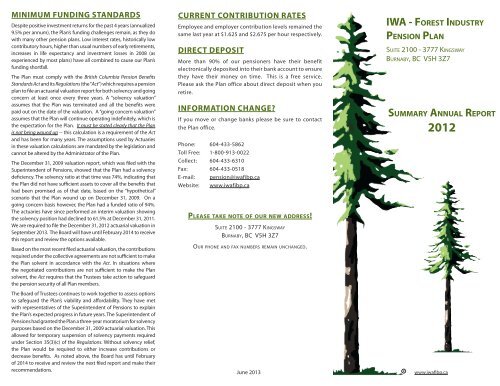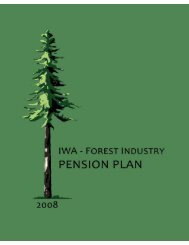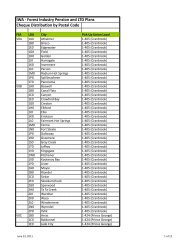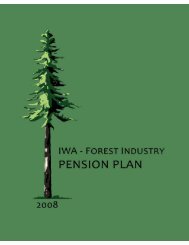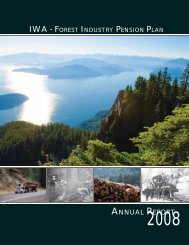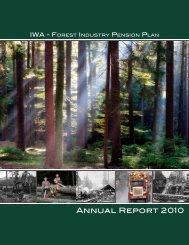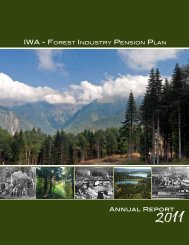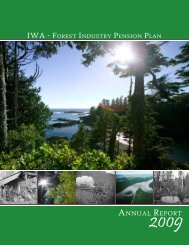Summary Annual Report 2012 - IWA Forest Industry Pension Plan
Summary Annual Report 2012 - IWA Forest Industry Pension Plan
Summary Annual Report 2012 - IWA Forest Industry Pension Plan
You also want an ePaper? Increase the reach of your titles
YUMPU automatically turns print PDFs into web optimized ePapers that Google loves.
MINIMUM FUNDING STANDARDS<br />
Despite positive investment returns for the past 4 years (annualized<br />
9.5% per annum), the <strong>Plan</strong>’s funding challenges remain, as they do<br />
with many other pension plans. Low interest rates, historically low<br />
contributory hours, higher than usual numbers of early retirements,<br />
increases in life expectancy and investment losses in 2008 (as<br />
experienced by most plans) have all combined to cause our <strong>Plan</strong>’s<br />
funding shortfall.<br />
The <strong>Plan</strong> must comply with the British Columbia <strong>Pension</strong> Benefits<br />
Standards Act and its Regulations (the “Act”) which requires a pension<br />
plan to file an actuarial valuation report for both solvency and going<br />
concern at least once every three years. A “solvency valuation”<br />
assumes that the <strong>Plan</strong> was terminated and all the benefits were<br />
paid out on the date of the valuation. A “going concern valuation”<br />
assumes that the <strong>Plan</strong> will continue operating indefinitely, which is<br />
the expectation for the <strong>Plan</strong>. It must be stated clearly that the <strong>Plan</strong><br />
is not being wound up -- this calculation is a requirement of the Act<br />
and has been for many years. The assumptions used by Actuaries<br />
in these valuation calculations are mandated by the legislation and<br />
cannot be altered by the Administrator of the <strong>Plan</strong>.<br />
The December 31, 2009 valuation report, which was filed with the<br />
Superintendent of <strong>Pension</strong>s, showed that the <strong>Plan</strong> had a solvency<br />
deficiency. The solvency ratio at that time was 74%, indicating that<br />
the <strong>Plan</strong> did not have sufficient assets to cover all the benefits that<br />
had been promised as of that date, based on the “hypothetical”<br />
scenario that the <strong>Plan</strong> wound up on December 31, 2009. On a<br />
going concern basis however, the <strong>Plan</strong> had a funded ratio of 94%.<br />
The actuaries have since performed an interim valuation showing<br />
the solvency position had declined to 61.5% at December 31, 2011.<br />
We are required to file the December 31, <strong>2012</strong> actuarial valuation in<br />
September 2013. The Board will have until February 2014 to receive<br />
this report and review the options available.<br />
Based on the most recent filed actuarial valuation, the contributions<br />
required under the collective agreements are not sufficient to make<br />
the <strong>Plan</strong> solvent in accordance with the Act. In situations where<br />
the negotiated contributions are not sufficient to make the <strong>Plan</strong><br />
solvent, the Act requires that the Trustees take action to safeguard<br />
the pension security of all <strong>Plan</strong> members.<br />
The Board of Trustees continues to work together to assess options<br />
to safeguard the <strong>Plan</strong>’s viability and affordability. They have met<br />
with representatives of the Superintendent of <strong>Pension</strong>s to explain<br />
the <strong>Plan</strong>’s expected progress in future years. The Superintendent of<br />
<strong>Pension</strong>s had granted the <strong>Plan</strong> a three-year moratorium for solvency<br />
purposes based on the December 31, 2009 actuarial valuation. This<br />
allowed for temporary suspension of solvency payments required<br />
under Section 35(3)(c) of the Regulations. Without solvency relief,<br />
the <strong>Plan</strong> would be required to either increase contributions or<br />
decrease benefits. As noted above, the Board has until February<br />
of 2014 to receive and review the next filed report and make their<br />
recommendations.<br />
CURRENT CONTRIBUTION RATES<br />
Employee and employer contribution levels remained the<br />
same last year at $1.625 and $2.675 per hour respectively.<br />
DIRECT DEPOSIT<br />
More than 90% of our pensioners have their benefit<br />
electronically deposited into their bank account to ensure<br />
they have their money on time. This is a free service.<br />
Please ask the <strong>Plan</strong> office about direct deposit when you<br />
retire.<br />
INFORMATION CHANGE?<br />
If you move or change banks please be sure to contact<br />
the <strong>Plan</strong> office.<br />
Phone: 604-433-5862<br />
Toll Free: 1-800-913-0022<br />
Collect: 604-433-6310<br />
Fax: 604-433-0518<br />
E-mail: pension@iwafibp.ca<br />
Website: www.iwafibp.ca<br />
Please take note of our new address!<br />
Suite 2100 - 3777 Kingsway<br />
Burnaby, BC V5H 3Z7<br />
Our phone and fax numbers remain unchanged.<br />
June 2013<br />
<strong>IWA</strong> - <strong>Forest</strong> <strong>Industry</strong><br />
<strong>Pension</strong> <strong>Plan</strong><br />
Suite 2100 - 3777 Kingsway<br />
Burnaby, BC V5H 3Z7<br />
<strong>Summary</strong> <strong>Annual</strong> <strong>Report</strong><br />
<strong>2012</strong><br />
R<br />
www.iwafibp.ca
TO ALL PLAN MEMBERS:<br />
This is a summary of key financial and other information related<br />
to the <strong>IWA</strong> - <strong>Forest</strong> <strong>Industry</strong> <strong>Pension</strong> <strong>Plan</strong> (the “<strong>Plan</strong>”) for the<br />
year ended December 31, <strong>2012</strong>.<br />
BASIC FINANCIAL STATEMENT<br />
Benefits under the <strong>Plan</strong> are provided from the <strong>Plan</strong>’s assets held<br />
in trust. In <strong>2012</strong>, the <strong>Plan</strong> received employer and employee<br />
contributions of $88,919,159 and had an investment gain of<br />
$270,558,180.<br />
The <strong>Plan</strong> had total expenditures of $241,369,494 which<br />
includes benefits paid to participants and beneficiaries of<br />
$236,866,147, administrative expenses of $3,659,532 and<br />
non-administrative expenses of $843,815. There were a<br />
total of 69,670 members or beneficiaries of the <strong>Plan</strong> at the<br />
end of the <strong>Plan</strong> year, although not all had yet earned the<br />
right to receive a benefit.<br />
$3,000,000,000<br />
$2,500,000,000<br />
$2,000,000,000<br />
$1,500,000,000<br />
$1,000,000,000<br />
$500,000,000<br />
$-<br />
Financial <strong>Summary</strong> (2003 - <strong>2012</strong>)<br />
$2,068,648,797<br />
Total Expenditures<br />
2003-<strong>2012</strong><br />
$2,915,476,327<br />
Total <strong>Plan</strong> Income<br />
2003-<strong>2012</strong><br />
The value of the Fund increased by $118,107,845 during<br />
<strong>2012</strong>. As a result, the net assets available to pay benefits<br />
at December 31, <strong>2012</strong> equalled $2,827,878,439, compared<br />
to $2,709,770,594 at December 31, 2011. This is the amount<br />
available to continue paying pensions to current pensioners<br />
and to provide future benefits for participants not yet retired.<br />
Billions<br />
$3.5<br />
3.5<br />
$3.0<br />
3.0<br />
$2.5<br />
2.5<br />
$2.0<br />
2.0<br />
$1.5<br />
1.5<br />
$1.0<br />
1.0<br />
$0.5<br />
0.5<br />
Market Value Asset Growth - 25 years<br />
INVESTMENTS<br />
With $2.83 billion in assets, the <strong>Plan</strong> earned a gross rate of<br />
return of 10.7% for <strong>2012</strong>, exceeding the benchmark of 8.8%.<br />
The <strong>Plan</strong>’s sound investment results were achieved despite<br />
the high level of financial market uncertainty that continues to<br />
plague the global economy.<br />
The sovereign debt crisis, which kept many European countries<br />
in recession, a slowdown in growth in emerging markets which<br />
in turn weakened demand for commodities, and the continued<br />
threat of global recession all contributed to market uncertainty.<br />
Despite these continuing challenges, the <strong>Plan</strong> has earned an<br />
annualized return of 9.5% per annum in the four years since<br />
the financial meltdown of 2008. This confirms our continued<br />
emphasis on investing for the long term, not for year over year<br />
results. <strong>Pension</strong> contributions made today may fund benefits<br />
paid out over 30 to 40 years. During the last decade, the <strong>Plan</strong>’s<br />
annualized rate of return was 7.7% per annum, a value added<br />
of 0.6%, over and above the 10-year annualized benchmark.<br />
Over 34 years, the <strong>Plan</strong>’s return has averaged 9.6% per annum.<br />
The assets of the <strong>Plan</strong> have increased by $877 million since<br />
2002. These results reflect our commitment to a clear longterm<br />
investment strategy from which we have never altered<br />
our course.<br />
MEMBERSHIP<br />
5.0%<br />
$2.3 billion increase in<br />
value since 1987<br />
$0.0<br />
1987 <strong>2012</strong><br />
Membership levels have shown a gradual decline over the<br />
last twenty years, decreasing by more than 60%. This can<br />
be attributed to a number of factors including the financial<br />
meltdown of 2008, the weakened US housing market, greater<br />
global competition, the rapid pace of technological change<br />
and automation within the forest industry. The number of<br />
pensioners has more than doubled in this same period. These<br />
factors influence the <strong>Plan</strong>’s financial obligations, making<br />
investment returns more important than contributions. On a<br />
positive note, there was a slight increase in active membership<br />
levels for the second staight year.<br />
80,000<br />
70,000<br />
60,000<br />
50,000<br />
40,000<br />
30,000<br />
20,000<br />
10,000<br />
0<br />
PENSIONS BY TYPE<br />
Many of our members are choosing to retire earlier than the<br />
normal retirement age (65) to take advantage of the subsidized<br />
early retirement reduction rates. This benefit allows active<br />
members to retire at age 55 or later without having their<br />
pension actuarially reduced for their age.<br />
Beneficiaries (both “pre” and “post” retirement) make up 16% of<br />
our pensions in payment.<br />
Beneficiaries -<br />
Pre-retirement death<br />
3%<br />
<strong>Plan</strong> Membership<br />
<strong>Pension</strong>ers &<br />
Beneficiaries<br />
Inactive<br />
Members<br />
Active<br />
Members<br />
1992 <strong>2012</strong><br />
<strong>Pension</strong> Types (<strong>2012</strong>)<br />
Beneficiaries -<br />
Post-retirement death<br />
13%<br />
<strong>Pension</strong>ers -<br />
Vested Deferred<br />
23%<br />
<strong>Pension</strong>ers -<br />
Normal (at age 65)<br />
7%<br />
<strong>Pension</strong>ers &<br />
Beneficiaries<br />
Inactive<br />
Members<br />
Active<br />
Members<br />
Limited Members<br />
1%<br />
<strong>Pension</strong>ers -<br />
Subsidized Early<br />
Retirement<br />
53%


